
Trillium erectum, the red trillium, also known as wake robin, purple trillium, bethroot, or stinking benjamin, is a species of flowering plant in the family Melanthiaceae. The plant takes its common name "wake robin" by analogy with the European robin, which has a red breast heralding spring. Likewise Trillium erectum is a spring ephemeral plant whose life-cycle is synchronized with that of the forests in which it lives. It is native to the eastern United States and eastern Canada from northern Georgia to Quebec and New Brunswick.

Heracleum is a genus of biennial and perennial herbs in the carrot family Apiaceae. They are found throughout the temperate northern hemisphere and in high mountains as far south as Ethiopia. Common names for the genus or its species include hogweed and cow parsnip.

Heracleum maximum, commonly known as cow parsnip, is the only member of the genus Heracleum native to North America. It is also known as American cow-parsnip, Satan celery, Indian celery, Indian rhubarb, poison turnip or pushki.

Hepatica is a genus of herbaceous perennials in the buttercup family, native to central and northern Europe, Asia and eastern North America. Some botanists include Hepatica within a wider interpretation of Anemone.
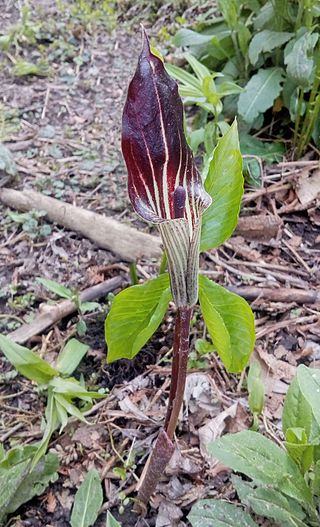
Arisaema triphyllum, the Jack-in-the-pulpit, is a species of flowering plant in the arum family Araceae. It is a member of the Arisaema triphyllum complex, a group of four or five closely related taxa in eastern North America. The specific name triphyllum means "three-leaved", a characteristic feature of the species, which is also referred to as Indian turnip, bog onion, and brown dragon.

Lamium galeobdolon (gah-lay-OB-dough-lon), the yellow archangel, is a species of flowering plant in the mint family Lamiaceae. It is native to Europe and western Asia but it is widely introduced in North America and elsewhere. It is the only species in the genus Lamium with yellow flowers. Another common name for this species is golden dead-nettle. In New Zealand, it is called the aluminium plant or artillery plant. The common names archangel and dead-nettle have been in use for hundreds of years, dating back to at least the 16th century.
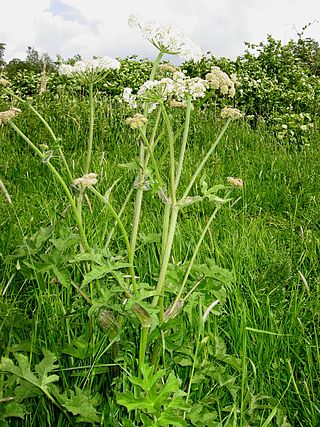
Heracleum sphondylium, commonly known as hogweed or common hogweed, is a herbaceous perennial plant in the carrot family Apiaceae, which includes fennel, cow parsley, ground elder and giant hogweed. It is native to most of Europe, western Asia and northern Africa, but is introduced in North America and elsewhere. Other common names include cow parsnip or eltrot. The flowers provide a great deal of nectar for pollinators.

Tiarella cordifolia, the heart-leaved foamflower, is a species of flowering plant in the family Saxifragaceae. The specific name cordifolia means "with heart-shaped leaves", a characteristic shared by all taxa of Tiarella in eastern North America. It is also referred to as Allegheny foamflower, false miterwort, and coolwort.

Tiarella, the foamflowers, is a genus of flowering plants in the family Saxifragaceae. The generic name Tiarella means "little turban", which suggests the shape of the seed capsules. Worldwide there are seven species, one each in eastern Asia and western North America, plus five species in eastern North America. As of October 2022, the taxonomy of Tiarella in eastern North America is in flux.
In botanical nomenclature, autonyms are automatically created names, as regulated by the International Code of Nomenclature for algae, fungi, and plants that are created for certain subdivisions of genera and species, those that include the type of the genus or species. An autonym might not be mentioned in the publication that creates it as a side-effect. Autonyms "repeat unaltered" the genus name or species epithet of the taxon being subdivided, and no other name for that same subdivision is validly published. For example, Rubus subgenus Eubatus is not validly published, and the subgenus is known as Rubus subgen. Rubus.
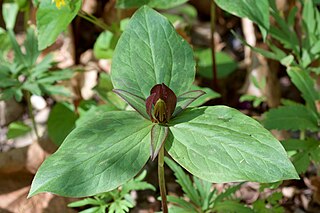
Trillium sessile is a species of flowering plant in the bunchflower family Melanthiaceae. The specific epithet sessile means "attached without a distinct stalk", an apparent reference to its stalkless flower. It is commonly known as toadshade or toad trillium. It is also called sessile trillium or sessile-flowered wake-robin, however it is not the only member of the genus with a sessile flower.
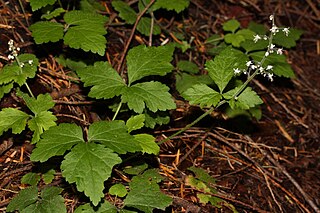
Tiarella trifoliata, the three-leaf foamflower, is a species of flowering plant in the family Saxifragaceae. The specific name trifoliata means "having three leaflets", a characteristic of two of the three recognized varieties. Also known as the laceflower or sugar-scoop, the species is found in shaded, moist woods in western North America.

Salvia canescens, the hoary sage, is a herbaceous perennial that is endemic to the Caucasus mountains. The specific epithet, canescens, refers to the off-white hairs covering the leaves.
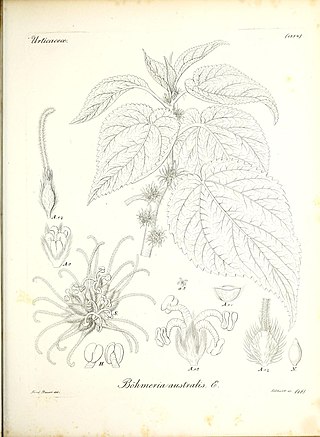
Pouzolzia australis, synonyms including Boehmeria australis and Boehmeria calophleba, is a species of large shrub or small tree in the plant family Urticaceae. It is endemic to small islands belonging to Australia and New Zealand – Norfolk Island, Lord Howe Island, and the Kermadec Islands. The population on Norfolk island, sometimes treated as a distinct subspecies, is critically endangered. In the Kermadec Islands, it was described in 2018 as "threatened – nationally endangered".

Desmodium glabellum is a species of flowering plant in the legume family Fabaceae. It is native to the eastern and central United States. It is commonly called Dillenius' tick-trefoil in honor of Johann Dillenius, a British botanist of German birth. It is also known as the tall tick-trefoil.

Symphyotrichum patens, commonly known as late purple aster or spreading aster, is a perennial, herbaceous plant found in the eastern United States.
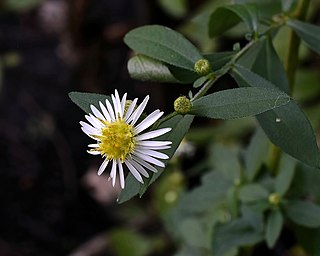
Symphyotrichum ontarionis is a species of flowering plant in the family Asteraceae native to eastern North America. Commonly known as Ontario aster and bottomland aster, it is a perennial, herbaceous plant that may reach heights of 120 centimeters. Each flower head has many tiny florets put together into what appear as one.
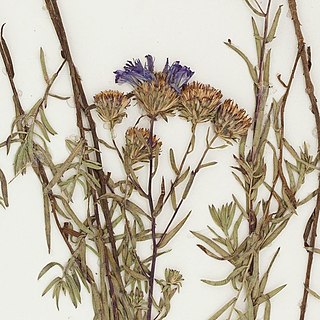
Symphyotrichum turneri is a species of flowering plant in the family Asteraceae native to Durango, Mexico.
Cardamine incisa is a species of flowering plant in the mustard family Brassicaceae.

Heracleum dissectum is a species of flowering plant in the family Apiaceae. It is found in Siberia and adjoining regions of northern Asia.

















